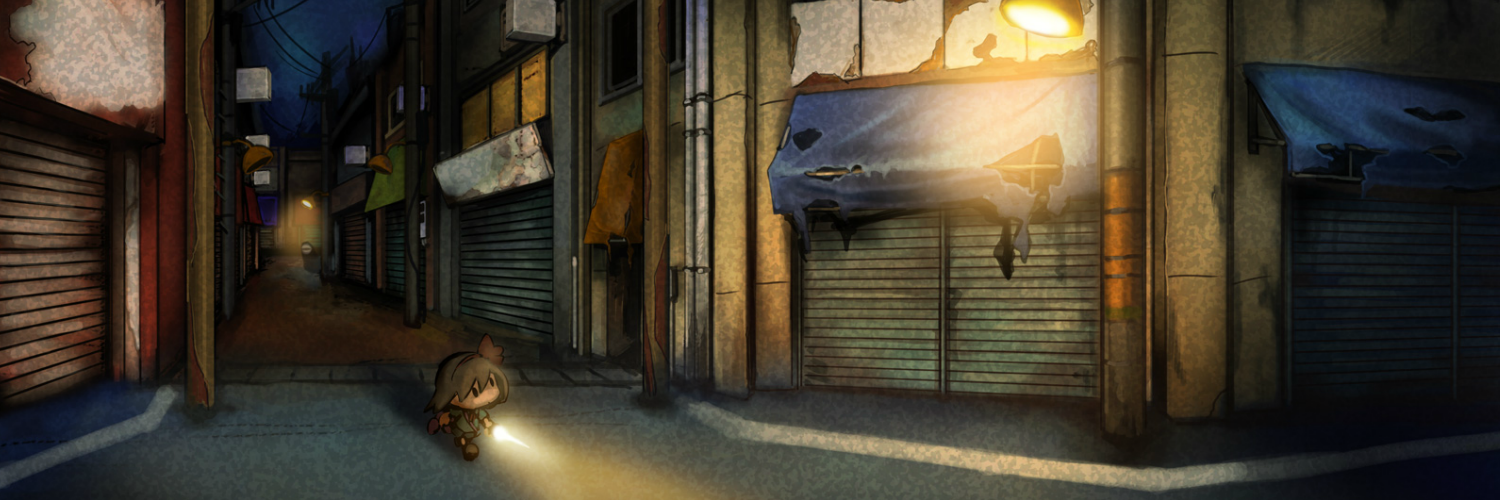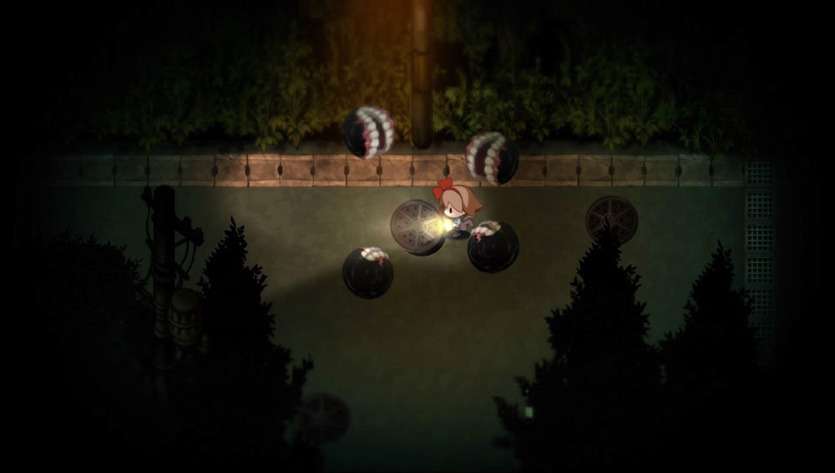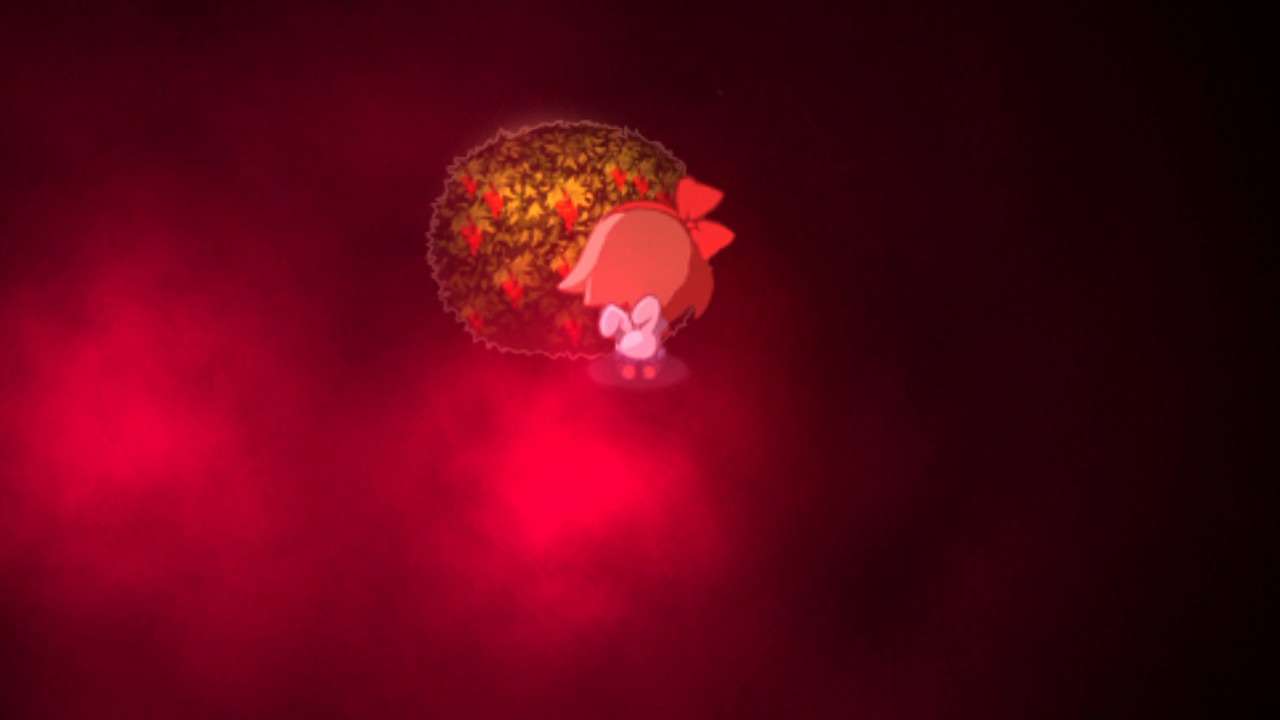
Yomawari: Night Alone Vita Review
Yomawari: Night Alone is the tale of a young girl who must face the demonic, haunted darkness of night in search of her sister and pet dog, Poro. Armed with a simple torch and a couple of distractions at best, she is left wondering alone in a nightmarish version of her home town. Not sure as to why she has been chosen to be the saviour of (or perhaps sacrifice to) the hellish spirits that have awakened and lie in wait around every corner, one thing is clear – she is being led by a malevolent force. The creatures vary from simple shadowy, scribbled figures, blobs, stars, all the way to grotesque manifestations and shocking monstrous demigods that stare endlessly through many eyes and impossible anatomy. The Japanese-horror cultural touch is unmistakable and holds up thematically for the entire experience. It is especially evident with the use of ‘releasing’ formerly evil spectres through respect and ritualistic offering. Also in the way twisted, dark stories of tragedy, revenge, and suicide are told throughout; being subtly revealed through brief notes and the placement of objects, characters, and enemies in the world.
Instantly the stylised, cartoony but eerie art style paired with the troubling absence of any music tightly grasps your attention unwaveringly. The game opens with a tutorial in the form of the protagonist walking Poro and throwing pebbles for him to fetch. It ends abruptly and in perhaps the most distressing, yet memorable way possible. It is the single moment of Yomawari that will stick with me forever, haunting my dreams, and it happens literally a couple of minutes in. After that emotional ripcord has been yanked, the young girl walks home where her sister makes her promise to stay put whilst she goes in search of Poro. Then, after a few hours of waiting the girl decides she needs to go find them both and so the game begins. From the tutorial, the player has already learned how to select and throw objects to distract foes, as well as how to move the character whilst slightly tilting the torch left or right of where she is facing. Now, to avoid harm, we are also shown that she can run, sneak, and hide behind particular objects to avoid certain death. Finally, it’s all tied together with the heartbeat system.

The heartbeat system is a low pounding sound/vibration that increases in frequency and volume the nearer enemies are. It’s also used when hiding. As the girl is covering her eyes in the foetal position she can’t see but can instead feel presences and these are shown visually to the player in the form of red clouds of beating smoke that move around, so it’s possible to know when to make a move and escape. It’s a nice way to hide the hideous fiends from sight whilst still showing how close they are to you, almost as if they would be right in front of your eyes once you stepped out of hiding. I believe the purpose of this detection system is to allow players to explore freely without being hindered by random, unseen deaths as it allows times for the player to stop running around and start sneaking; carefully looking out for any problems. It’s unfortunate, then, that sometimes you are still randomly insta-killed by horrible things just running directly for you from off screen. Fortunately, the quick save / fast travel Jinzo statues are placed all over the town and no progression or items are lost for dying.
Still, though, it can be aggravating and these deaths from enemies that are faster than your walk speed is made even more irritating because of the use of stamina that decreases slowly when running normally but simply drains in a second when near enemies. I understand that the player shouldn’t be able to run circles around these beings but to have at least enough time and energy to avoid these pace-destroying threats would have been nice. It’s especially noticeable when, to continue the story, it is necessary to have to make it past swift enemies that chase you down, or many enemies at a time with absolutely no leeway like the worst possible quick time event. It turns the once scary enemies into nothing more than annoyances as you die again and again trying to zig-zag between them with all the speed of an asthmatic tortoise. It will always be scarier to be chased than to be caught in games because when you’re caught what can they do? The illusion of fear is shattered.

Another great example are the enemies that are activated by light, but as some monsters can only be seen in the light it’s not possible to simply go without. This forces the player to have to carefully manoeuvre through both types of spirit with caution, but if the torch is shined briefly in the wrong direction you will be charged to death with zero chance of escape. Wouldn’t it have been much scarier to have had to turn off the torch and run away for a while, fearing the chase and the darkness instead of simply being made to start again? Then, on the other hand, when sneaking past regular enemies it’s made far too easy to make them look like idiots as you waddle past groups of demonic spirits, constantly outwitting them; destroying any sense of power they previously held. The incredible potential for having to provoke enemies and narrowly escape or hide in order to get around them is simply missed and replaced with a system of trial and error.
The balance on both sides feels like it needed tweaking just that little bit to have had it seem to the player that they could be caught any second, constantly bringing that tension to a boil before making it out, allowing them to take that quick breather before it starts all over again, exactly how great horror games have done it in the past. It’s a shame that it is the final boss where this balance has been perfected as you must run and hide from a couple of large spirit hands as you aggro them to into moving away from the shrines they are protecting. The battle in your brain between risking a quick chance at making it to the next hiding spot before being caught or waiting it out until they leave is stressful in that ideal way that horror game players live for. The adrenaline rush of making that mad dash for safety is incredible, however brief and I only wish the rest of the game could have followed suit.

Besides the dodging of bad things, the rest of the game is made up of basic exploration. Shine your light in areas and pick up sparkly objects. At first it’s great to be wandering the gloomy town, imagining what mystical, or possibly sickening, things could be discovered next, but when the game requires certain objects be found in order to move on it warps the desolate landscape into a grid of which you must search every square inch. There are no real puzzles, thinking is not necessary and that is where I was most disappointed. Having to trudge the entire map, avoiding the same old ghosties in the same old places, in search of a tiny sparkle that can be so easily missed, especially if being chased, is absolutely not fun. Although, there are several optional events that are just wonderful. My favourite is all about the death of a girl after falling off of a cliff. Morbid, certainly, but the uncovering of bits of the story from messages on noticeboards and items found lying around all whilst being chased by her tormented soul is simultaneously chilling and luring. Eventually, after returning her broken necklace to her body she can be at peace and will no longer be around to attack innocents. It was up to the player to solve what needed to be done and to piece together the history. It felt like an accomplishment. Sadly, these optional side events are few and not all of them nearly as deep as that one.
However, as originally mentioned, even though the gameplay is lacking, the atmosphere is pristine. The town is a decent size and the 5-hours-ish playtime meets the demands of the experience and nothing more. Albeit, I would still recommend Yomawari: Night Alone to any horror fans simply on the basis of it being unique, but if that’s not what you’re looking for and nothing short of a terror-inducing masterpiece will do, I’m afraid it’s back to Silent Hill 2. Until we do get that next genre-defining horror gem, Yomawari is a nice distraction that will hopefully be worked on to bring us something even more sinister and satisfying in the future.
